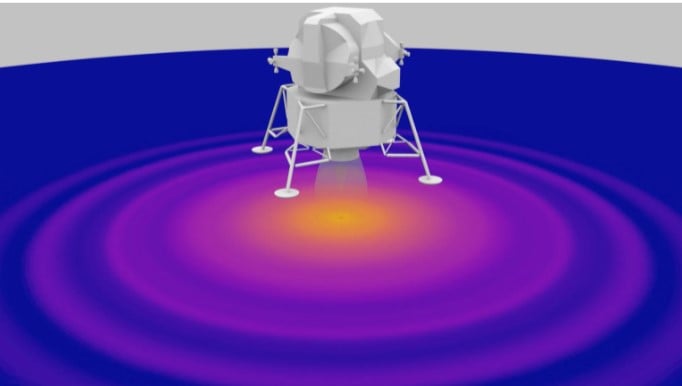When spacecraft land on the Moon, their exhaust strikes the powdery regolith on the lunar surface. The Moon has low gravity and no atmosphere, so the dust is thrown up in a huge plume. The dust cloud could possibly interfere with the navigation and science instruments or cause visual obstructions. Additionally, the dust could even be propelled into orbit, risking other spacecraft nearby.
In working to better understand the impact future landers might have on the lunar surface, NASA has developed a new supercomputer simulation. They used it to predict how Apollo 12's lunar lander exhaust would interact with regolith, then compared this to the actual results of the landing.
Researchers at NASA's Marshall Space Flight Center in Huntsville, Alabama developed the new software to study plume-surface interactions (PSI). This gives engineers and scientists the tools to predict how various systems like SpaceX's Starship or Blue Origin's Blue Moon lander will affect the lunar surface, such as cratering or visual obstructions.
The team at Marshall recently produced a simulation of the Apollo 12 lander engine plumes interacting with the surface. The simulations ran on the Pleaides supercomputer at the NASA Advanced Supercomputing facility at NASA's Ames Research Center in California's Silicon Valley over several weeks of runtime, generating terabytes of data.
NASA said the simulation predicted erosion that closely matched what happened during the landing, based on images and video from Apollo 12.
The simulation shows the last 30 seconds of descent before engine cut-off, showing the predicted forces exerted by plumes on a flat computational surface. The simulation looked at shear stress, which is the amount of lateral, or sideways, force applied over a set area. In the video, you can see changing radial patterns which portray the intensity of predicted shear stress. Lower shear stress is dark purple, and higher shear stress is yellow.
Shear stress is the leading cause of erosion as fluids flow across a surface
The new software will help improve engineers' understanding of plume-surface interactions. "These tools are helping NASA minimize risks to spacecraft and crew during future landed missions," NASA said.
Read more:
https://www.nasa.gov/general/rocket-exhaust-on-the-moon-nasa-supercomputers-reveal-surface-effects/
 Universe Today
Universe Today

